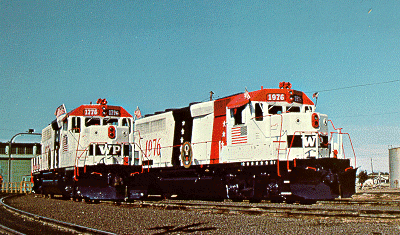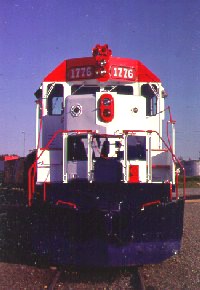

The Bicentennial Twins pose in Stockton
for photographer Henry Brueckman in this 1976 photo that was later made
into a Chatham Publishing Company postcard. Though undated, the date
in fact is probably May 6th, when the newly released 1976 was brought together
with the 1776 for the first time specifically for photographs.
In early 1976 America's Class 1 railroads had Bicentennial Fever, painting one or more diesels in some form of red, white and blue paint scheme. Western Pacific was not to be left out and chose two units to represent the company as Bicentennial flagships.
The Chosen Two were GP40s 3540 and 3541, which when adorned in their shiny new patriotic dress became the 1776 and 1976 respectively. The 1776 (nee 3540) was painted in March of 1976 then spent a month touring the system along with a matching set of four freight cars and specially painted caboose 474. WP's marketing department had a field day premiering the flashy unit for the press in Oakland on March 24th, and again on the 27th when the unit was dedicated as part of the City Of Oakland's Bicentennial celebration. From Oakland the 1776 left on a 2,000 mile system-wide tour with its' special train in tow.
Road Show
 |
|
| On display during 1776's coming out party. Note the use of red and blue on the nose. |
The train was displayed at WP's major terminals beginning with Stockton, then Oroville, Elko (on April 1st) and Salt Lake City (on April 4th) at the DRGW depot (which was not in service in those days). Then it was back west to Stockton heading the PBF, after which the unit was cleaned and serviced during a three day layover. On April 8th, 1776 was on the point of the San Jose Turn, bumping the famous F-units from their normal assignment as it cut off its special train in Milpitas before moving the last miles to William Street Yard in San Jose.
The 1776 was finally released into general freight service on April 11th, where it headed the WPX all the way to Salt Lake City.
1976 Emerges
While all this hubbub was going on, the paint crew
quietly pulled the 3541 from service, sandblasted its paint down to the
metal and applied an almost identical coat of paint to the newly emerged
1976. The only differences between the two unit's paint schemes was the
1976's cab sides featured a 50-star flag instead of the 13-star flag shown
on the 1776; and the round seals affixed to the handrails of each unit.
The 1776 featured a seal showing the Liberty Bell with 1776-1976 on either
side, and the 1976 showed off the Presidential Seal. It should be noted
that when the 1776 first emerged from the paint shop it was equipped with
a Presidential Seal, but once the 1976 was released the seal was changed
to the Liberty Bell version just described. The result of this is that
early photos of the 1776 do show the Presidential Seal while later ones
will yield the Liberty Bell seal.
|
|
| It's July 4th, 1976 and WP 1976 and 1776 arein San Francisco to help celebrate the bicentennial as part of a three railroad display along the Embarcadero. The San Francisco Belt Railway donated use of the tracks. (Ken Rattenne photo) |
Bicentennial Celebration
The career climax for these flashy celebrates came on the July Fourth weekend of that Bicentennial year when the pair were ferried across San Francisco Bay and put on display in the "City by the Bay" for the holiday weekend celebrations. Placed for optimum public viewing, the tiny San Francisco Belt Railway hosted a colorful display of red, white and blue railroad equipment from four railroads along its pier-side trackage on the Embarcadero.
WP's two GP40s were definitely the show-stealers with the now familiar 5-car bicentennial train, eclipsing the other attendees. SP, which also had two Bicentennial engines, chose to display its resident commute unit, GP40P-2 3197, freeing it's Cotton Belt SD45T-2 to make an appearance elsewhere. Also in attendance were Santa Fe's SD45-2 5701 (one of five matched-set units, and Amtrak's F40PH 203, along with a brand new Amfleet coach.
The freight cars loaned to WP for the celebration were: covered grain hopper (PTLX 1776 loaned by Pullman Transport Leasing, insulated boxcar USLX 364 loaned by Canadian Forest Products Ltd., a WP flat car with two piggyback vans painted in a Bicentennial scheme, WP 65440 (painted in standard brown and white) and WP caboose 474 in standard red with a bicentennial seal applied to the sides.
Once the hoopla was over the 1776 and 1976 continued on in general freight service until 1979 when both were repainted and renumbered back to Perlman Green. Less than a year later, on April 9th, 1980, the 3540 perished in a fiery derailment at Hayward, CA.
The lone survivor of the pair, the 3541, now earns
a living hauling freight for regional railroad Wisconsin Central as their
No. 3023. Truly a fitting end for a colorful unit.
| UNIT NO | BLT | OLD# | DISPOSITION |
| 1776 | 1970 | ex-3540 | Painted for Bicentennial 3/76, renumbered back to 3540 1979; destroyed 4/9/80 in Hayward, CA. |
| 1976 | 1970 | ex-3541 | Painted for Bicentennial 4/76, renumbered back to 3541 1979; returned to lessor by UP, became CMW/GTEW 3023, WC 3023. |